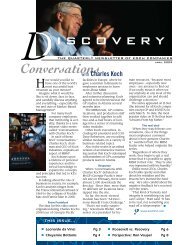Standing on principles
October 2009 - Koch Industries, Inc.
October 2009 - Koch Industries, Inc.
You also want an ePaper? Increase the reach of your titles
YUMPU automatically turns print PDFs into web optimized ePapers that Google loves.
Health carelessness<br />
The debate over changes to the U.S.<br />
health care system has g<strong>on</strong>e global.<br />
No matter where you live, it seems, it’s<br />
easy to criticize your health system.<br />
In England, where increased taxes have<br />
more than doubled funding for the Nati<strong>on</strong>al<br />
Health Service, the average wait<br />
for hospital treatment last year grew to<br />
49 days. Getting a new digital hearing<br />
aid can take five years.<br />
In Canada, Nova Scotia and Ontario<br />
towns have held lotteries to decide who<br />
gets to see the doctor.<br />
Even the World Health Organizati<strong>on</strong>’s<br />
highest-rated health care system has<br />
serious shortcomings. Following a<br />
2003 heat wave in France, more than<br />
15,000 of that nati<strong>on</strong>’s elderly died due<br />
to a lack of hospital facilities and too<br />
few available doctors.<br />
And then there is the United States,<br />
where soaring health care costs, milli<strong>on</strong>s<br />
of uninsured and an insurance bureaucracy<br />
are Exhibits A, B and C for those<br />
who favor universal, centrally c<strong>on</strong>trolled<br />
or so-called “single payer” health care.<br />
What’s wr<strong>on</strong>g<br />
From a market-based perspective, all<br />
of the world’s health care systems have<br />
significant problems, most notably a<br />
disc<strong>on</strong>nect between the c<strong>on</strong>sumer and<br />
the actual cost of the service provided.<br />
In most developed nati<strong>on</strong>s, the government<br />
decides what kind of health care<br />
is available and rati<strong>on</strong>s it accordingly.<br />
Patients may never receive a bill for<br />
services (they’re already paying it via<br />
taxes), but wait times and the limited<br />
range of available services bring about<br />
an unhealthy system.<br />
Those who feel shortchanged by this<br />
approach must either do without or<br />
c<strong>on</strong>tract for private services, which, in<br />
some countries, is illegal.<br />
In the U.S., a combinati<strong>on</strong> of government<br />
agencies and insurance companies<br />
has taken over most health care<br />
decisi<strong>on</strong>s, including what’s covered or<br />
not covered, and at what cost.<br />
There are plenty of private sector insurance<br />
plans in the U.S., but, in reality,<br />
almost all of them closely reflect government<br />
guidelines for reimbursement.<br />
Thanks to a complicated system of copays,<br />
preferred providers and third-party<br />
billing, most patients in the U.S. have no<br />
clue as to the actual cost of their care.<br />
For that matter, neither do most patients<br />
in countries with nati<strong>on</strong>alized health care.<br />
Perverse incentives<br />
Being c<strong>on</strong>nected with the true cost of<br />
health care provides a powerful incentive<br />
for managing costs. Unfortunately, that<br />
c<strong>on</strong>necti<strong>on</strong> has been seriously eroded.<br />
In 1960, Americans pers<strong>on</strong>ally paid<br />
for 47 percent of all health care procedures.<br />
Altogether, the private sector<br />
paid 75 percent.<br />
Today, the private sector pays 54 percent<br />
and individuals pay barely 10 percent.<br />
Over that same period, government’s<br />
share of health care payments has almost<br />
doubled, from 25 percent to 46 percent.<br />
Because so much of health care is now<br />
paid for by third parties, including<br />
government programs such as Medicare,<br />
health care as a percentage of U.S.<br />
Gross Domestic Product has swollen<br />
from 5.5 percent to more than 16 percent<br />
of GDP.<br />
This increase in the porti<strong>on</strong> of health<br />
care paid for by third parties is partially<br />
driven by a perverse tax incentive:<br />
employer-paid insurance premiums<br />
are typically deductible while pers<strong>on</strong>al<br />
payments generally are not.<br />
“The tax imposed under this secti<strong>on</strong> shall not be treated as a tax.” - HR 3200 (“Affordable Health Care Bill”), pg. 203.<br />
Doctors also face perverse incentives.<br />
Many physicians feel pressured to perform<br />
extra services and order additi<strong>on</strong>al<br />
tests in hopes of avoiding lawsuits.<br />
Patients seldom have the incentive<br />
to work with doctors to optimize the<br />
trade-offs between quality of treatment<br />
and cost.<br />
Essential ingredient<br />
Another factor driving costs higher is<br />
the lack of competiti<strong>on</strong>.<br />
In free markets, competiti<strong>on</strong> improves<br />
quality, expands choices and lowers costs.<br />
But in the global health care market, competiti<strong>on</strong><br />
is an endangered species.<br />
In the UK, for example, citizens can lose<br />
4





